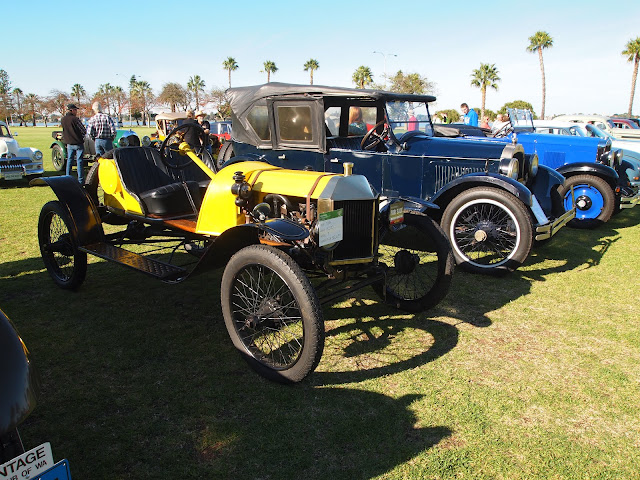
The Veteran Car Club held a display at Langley Park in Perth on 20 May 2012 for National Motoring Heritage Day (http://www.veterancarclubofwa.asn.au/). There were approximately 100 cars on display, which was a little down on expectations as there were quite a few competing automotive and heritage events also on that weekend, including the British Car Day in Gin Gin and the Defence Force Air Show at Pearce so the expected numbers were a little down. Nevertheless it was a good show and there was a lot of public interest.

It was a beautiful sunny day - warm but not too hot. Quite fortunate for this time of year.

It isn't all old cars. The Shelby-Mustang Club, which is an affiliate of the Veteran Car Club, brought along a large contingent.

Shelly and I brought Daisy down. There was an interesting array of cars on display but we were the only German car, apart from Richard's NSU Prinz, which he bought along for a short time.
I was surprised when two older gentlemen came up and advised they either owned or had friends who owned DKWs during the 1930s. One gentleman complained that the wooden chassis on his DKW was weak and began to warp. He'd repaired the chassis frame with lengths of angle iron before eventually disposing of the vehicle. The other gentleman reported how his friend had left his DKW parked on a beach after a night of misadventure and came back the next day to find it was flooded. They tipped the car over on its side and emptied out the water and drove away. We also met a French man and a Kiwi who both recognised the car and came over for a chat, but most people knew nothing about DKW at all.

A magnificent 1958 Cadillac El Dorado. The boot was enormous.

Laurie Mariani's 1959 Dodge Coronet. The car is licensed as a small charter vehicle and is available for weddings.

Beautiful tail fins and brake lights.

A sweet Ford Thunderbird.

1947 Packard Clipper and a 1937 Oldsmobile


1940 Oldsmobile

1938 Plymouth in unrestored condition

1937 Buick

1950s Riley

1946 Sunbeam-Talbot Ten,

1934 Rolls Royce Phantom

1946 Jaguar SS. The venerable Jaguar name we know today was originally the model designation for the sports car manufactured by SS Cars Ltd. SS Cars was an offshoot of the Swallow Sidecar and Coachbuilding company. They split off a subsidiary to build sports cars in 1934, one of which was the Jaguar. After the Second World War the company change its name to Jaguar as SS had unfortunate associations with the Nazi secret police.

1938 Alvis saloon

1954 MG TF. Shelly would love one of these.

Morgan Plus Four. Morgan is one of the few independent car companies remaining. They continue to manufacture their cars by hand in their small factory in Malvern, England. Here's a video from the factory.

I think this is a Triumph Spitfire

The Chevrolet parked next to us has a 3.1 litre engine, more than three times the size of Daisy's meagre 896ccs.

Ford A Coupe

Fords and Chevrolets

A rolling work of art. This beautifully restored Cadillac V8 Type 341A deserved 'best in show.'


Rolls Royce, 1911 Ford T, and a Willys-Knight. The Willy's is in completely original condition and has never been restored.

An unusual marque. Case were famous for their tractors and agricultural machinery but they also built cars between 1911 and 1926. This is a late Case tourer dates from approximately 1925.

Case logo.

A lovely Austin 8

Another unusual marque - a Fargo Truck. Chrysler created the Fargo brand in 1928 and although hardly known in Australia they continued to manufacture them right into the 1970s. The brand was eventually sold off to Turkey, which continue to manufacture them under the name Askam. http://www.allpar.com/old/fargo.html

Fargo badge

I couldn't identify this little moped.


Chrysler racer

Another rare marque - 1925 Bean. http://www.localhistory.scit.wlv.ac.uk/Museum/Transport/Cars/Bean/Cars.htm

Bean logo


Fiat. There were three old Fiat's present.

Bentley

Another rare marque -1920 Cubitt C1 Tourer, http://www.oldclassiccar.co.uk/cubitt.htm

1920s Vauxhall

1926 Humber

Samantha the 1929 Austin Seven. This car was found abandoned in a barn in 1964 and then driven around the world between 1965 and 1972. The car covered over 50,000 miles on a journey across 35 countries including Iran, Afghanistan, North and South America and Africa before finally settling in Australia. The owners published a book called 'Seven Years with Samantha.'

Another Austin Seven. These are such lovely little cars.

1914 Trumbrell

1913 Model T racer

1924 Amilcar C4

Amilcar and a 1925 Fiat 501

Fiat

Interestingly, I've been sent a couple of very early photos of my uncles 1913 Nazzaro from the 1930s and it features this same curved bodywork. Perhaps this is a particularly Italian style. I'll put up the photos in the Nazzaro post shortly.

Rover. This car regularly attends Veteran events around Perth.

1910 Brush Model D runabout. It was in a car like this that the first cross Australia journey was made in 1912.

1911 Maxwell. This American veteran was imported by the Veteran Car Club recently and put up for sale to members.

This 1911 Model T is for sale.


A 1913 Model T tourer

1911 Star limousine

1911 Wolsley-Siddley limousine

1910 Fuller buggy. This car was left to the Veteran Section in the original owners will.


1909 Deasy. This marque is related to the Wolsely-Siddley photographed above.

1924 Delage

The extraordinary 1906 De Dion Bouton.

The Military Section had a small display of jeeps.












